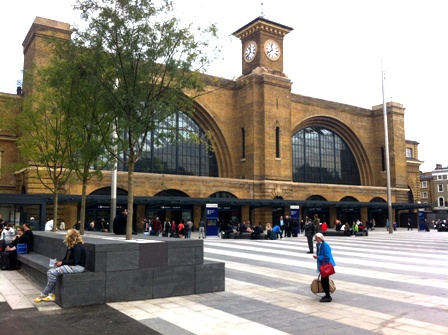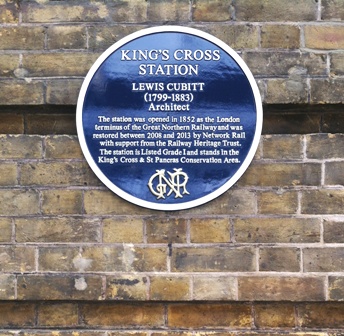
New approach: King's Cross now thankfully free of its 1960s adornments
From King’s Cross to Soho: a new understanding of urban open space
Having visited the newly revealed frontage of Kings Cross station and headed off in search of refreshment, Jonathan Ives was forced to consider how the understanding of traffic and transport is changing perceptions of urban open space and even the acceptance of modern economic conventions.

New approach: King's Cross now thankfully free of its 1960s adornments
King’s Cross station was once the centrepiece of one of London’s least romanticised areas, its name synonymous with sleaze and neglect. Now it is the hub of an area that is becoming with innovation and regeneration, home to big brands such as The Guardian and Google. The final part of the station’s restoration was the removal of the single-storey 1960s shed that had served as an entrance hall to reveal the building’s original face, an arched brick elevation that is central to the station’s Grade I listing.
Where the white plastic and glass shed once stood is now an extensive concourse thronged with pedestrians moving en masse to and from King’s Cross and the adjacent St Pancras, itself the recent beneficiary of regeneration and reinvention that rediscovered William Barlow's masterpiece under centuries of soot and diesel debris. This concourse is another example of how urban open space is gaining a foothold in our understanding of what and how cities should be. Public parks are properly lauded for their contribution to urban wellbeing but the non-green open spaces, the concourse and the square, the walkways and the thoroughfares, are enjoying something of a regeneration themselves.
Step away from King’s Cross – or better yet climb the stairs to the elevated terrace in front of St Pancras – to get a better view and it is not hard to develop a logical progression from architecture to planning, from planning to transport, and from transport to open space. With King’s Cross and St Pancras in view one can appreciate that these are grand buildings with impressive façades and elevations that require space around them to ease the comings and going of their purpose and business but also to facilitate our admiration. We need some space to stand back and admire the architects’ vision, wonder at the builders’ efforts and marvel at the human condition.
However, the space in which we stand, this place of pedestrian admiration, is the realm of the planners, where these much-maligned public servants try to balance and blend the demands of various vested interests, making space for commerce and community, profit and people, business and beauty. After decades of the regular visitor marvelling at the neglect of St Pancras and the poverty of ambition and imagination evident in the hasty and ugly remodelling of King’s Cross, it is an area that now seems to be part of a growing understanding that our towns and cities are for people and that people should be allowed, encouraged, helped even, to move around their urban environments freely, pleasantly and easily.
An acceptance of the primacy of people within the city permits an acceptance of the fact that a vast majority of journeys within and around a city are made on foot. Once we recognise this we must also recognise that the obsession with making cities convenient for cars is redundant. Thus a new urban paradigm emerges in which movement replaces transport as the primary focus of how a city works.
Having stepped back and away from King’s Cross the better to view its newly visible brickwork and consider its relationship with the neo-gothic elaborations of St Pancras, we might decide to head south, perhaps with a thought to breakfast in Bloomsbury, coffee in Covent Garden or even an early lunch somewhere suitably louche; Soho is only a 15-minute walk away and the whole city is here to be explored.
However, at once the Euston Road intervenes. Here the context and conflict of urban open space is admirably highlighted. Running east-west, this is one of London’s busiest traffic routes. Habitually choked with traffic swapping between truncated acceleration or hectic rest, this is the road that must be crossed to continue the journey and several things are noticeable as we wait among the mass of pedestrians waiting for the crossing signal to show green.
First, we notice how constrained and constricted this artery of transport seems to be, how slowly the traffic is moving. Then we see how this choked and choking road is infiltrated, either by people on foot squeezing though the stationery cars, cabs and trucks, or by bicycles shimmering through even this most hostile of environments, drawn too, one presumes, by the promise of the quickest route through town. Then, as the green man shows and we move across the road, how much traffic, whether motored or pedalled, wheeled or walking, is packed into this tiny corridor. Huge numbers of people are using the Euston Road as their route and moving on to the pavement on the other side of the road from King’s Cross station, we notice how many of them are on foot and how many are sat behind steering wheels; there are many more people walking across, along and around the road than are driving along it despite the apparent contradiction of the space allocated to pavement and carriageway.
Across the road and away from the vehicles we are free to wander through the side streets and squares of Bloomsbury towards whatever destination we find alluring. On foot in London and other cities we are forced to reflect on what may well prove to be a new understanding of open space in the modern urban environment. We may envisage a spectrum of urban space, with parks and gardens at one end and arterial roads at the other. The demands of business and transport lobbies have traditionally compelled the focus of funding and political attention to be firmly set at the road end of this spectrum but after the small number of post-war decades in which the needs of the car and its driver were deemed to be king the consensus seems to be shifting towards a recognition that the people who work and live in our cities have been ill-served by the fetishisation of the car and the fashions for urban design this required.
Not too long ago expressing the view that parks and squares, walking and bicycles should be the natural order of the urban environment was to risk being labelled a dreamer or a crank. Now such a view feels more like an expression of common sense and it is a view finding increasing traction within local and even central government. The authorities that control how our cities look and function are recognising that wanting to walk or cycle is not the action of a dedicated contrarian out of step with the rest of society but instead a sensible and cost-effective option in the face of other outmoded options.
Choosing move under one’s own steam, whether by walking or cycling, was not an obviously revolutionary act but such simplicity does increasingly seem to have proved the case. People deciding that it is more enjoyable and no slower to walk rather than get on a bus on the tube lead to a demand for their space in the city. People simply deciding that they could ride a bike around town have brought about a wholesale reimagining of transport priorities across the capital, with other towns and cities across the UK following suit.
Such decisions about how we move around the city lead inexorably to questions of how we live in the city and who can now afford the luxury of being able to walk or cycle to work. These questions have profound implications for the shape and infrastructure of our cities and also for the understanding of how our systems of economic management, taxation and property ownership should be shaped. Who is being excluded from living in such proximity to their work places and why? What needs to be done to make such sustainable and positive environments accessible to many more people? Why is it now so expensive to own and rent accommodation in our towns and cities? When could we address these issues? Where am I going to leave my bike?
It is a long way from the celebration of a station façade to a reimagining of our national economy, some might say a step too far, but there is a clear path from one to the other. It is a truism that the longest journey starts with a single step but the growing sound of footsteps may soon be too loud for our politicians to ignore.
Jonathan Ives is the editor of The Leisure Review.
The Leisure Review, December 2013
© Copyright of all material on this site is retained by The Leisure Review or the individual contributors where stated. Contact The Leisure Review for details.
![]() Download a pdf version of this article for printing
Download a pdf version of this article for printing
This article was amended on 12.12.13 to correct an error of fact. St Pancras was designed by William Barlow, not Brunel as the article originally stated. Many thanks to Mike Piet for pointing this out.
